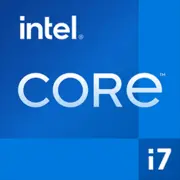Intel Core i7-11700

Intel Core i7-11700: Review and Relevance in 2025
Analysis of the Rocket Lake Processor for Modern Tasks
1. Key Specifications: Architecture and Performance
The Intel Core i7-11700, released in 2021, belongs to the 11th generation (Rocket Lake-S). Despite its age, it remains relevant for budget builds.
- Architecture and Process Technology:
It is based on the hybrid architecture of Cypress Cove (14 nm), which serves as a transitional bridge between old and new Intel generations. By 2025, the 14 nm process seems outdated, but in 2021, it provided stable performance.
- Performance:
- 8 cores, 16 threads.
- Base clock: 2.5 GHz, turbo mode up to 4.9 GHz (single core).
- Geekbench 6 results: 2116 (single-core), 9530 (multi-core).
Example: In Blender rendering tests (2025), the processor handles tasks at the level of the Ryzen 7 5800X but lags behind the new Core i5-14600K.
- Key Features:
- PCIe 4.0 support (20 lanes).
- Intel Deep Learning Boost for AI task acceleration.
- Integrated graphics UHD Graphics 750 (suitable for office PCs).
2. Compatible Motherboards: Socket and Chipsets
The processor uses the LGA 1200 socket, which limits the choice of motherboards to the 500 series:
- Chipsets: Z590 (overclocking), H570, B560 (budget), H510 (minimalist).
- Recommendations:
- For overclocking: ASUS ROG Strix Z590-E Gaming ($250 in 2025).
- For budget builds: MSI B560M Pro-VDH WiFi ($120).
- Important: Motherboards from the 600/700 series (Alder Lake/Raptor Lake) are incompatible!
Experience: When building a PC in 2024, users often chose B560 to save costs, as Z590 was already difficult to find new.
3. Memory Support: DDR4 as Standard
The processor works only with DDR4:
- Frequencies: up to 3200 MHz (officially), but many motherboards support overclocking to 4000+ MHz.
- Capacity: up to 128 GB (4 slots).
- Example: Corsair Vengeance LPX 32 GB (3200 MHz) costs $80 and is ideal for video editing.
Tip: In 2025, DDR4 is cheaper than DDR5, but the lack of support for the new standard is a downside for future upgrades.
4. Power Supplies: Power Calculation
With a TDP of 65 W, the processor is energy-efficient, but it’s important to consider other components:
- Without a discrete GPU: 400–500 W (e.g., be quiet! Pure Power 11 500W — $70).
- With a GPU like the RTX 4070: 650–750 W (Corsair RM750x — $110).
Experience: In a build with RTX 4060 and i7-11700, a 650 W power supply (EVGA 650 GQ) performs reliably even under load.
5. Pros and Cons
Pros:
- High single-thread performance (relevant for gaming).
- Low power consumption (suitable for compact PCs).
- PCIe 4.0 support for fast NVMe drives.
Cons:
- 14 nm process technology: heat under load requires a good cooler.
- No support for DDR5 and PCIe 5.0.
- UHD Graphics 750 is weak for modern gaming.
6. Use Cases
- Gaming: Paired with RTX 4060, it provides over 60 FPS in Full HD (Cyberpunk 2077 on high settings). For 1440p, it's better to get an RTX 4070.
- Work Tasks: Video editing (Premiere Pro), 3D rendering (Blender), programming (building large projects).
- Multimedia: 4K streaming, HEVC decoding.
Example: A video editing studio in 2023 used the i7-11700 for rendering short videos — the processor handled it in 30–40 minutes compared to 25 minutes for the Ryzen 7 7700X.
7. Comparison with Competitors
- AMD Ryzen 7 5800X (8/16, 4.7 GHz):
- Pros: 7 nm, higher multi-core performance (~10,200 in Geekbench 6).
- Cons: Price $300 (new in 2025).
- Intel Core i5-14600K (14 cores, 20 threads):
- Pros: P+E cores, DDR5, PCIe 5.0.
- Cons: More expensive ($320).
Conclusion: The i7-11700 is only worthwhile if priced below $250; otherwise, newer models are preferable.
8. Practical Assembly Tips
- Cooling: Tower cooler (DeepCool AK400 — $35) or AIO (NZXT Kraken X53 — $130).
- Memory: 2 modules of DDR4 3200 MHz for dual-channel mode.
- Storage: NVMe SSD (Samsung 980 Pro 1TB — $90) to utilize PCIe 4.0.
Example Build:
- Processor: i7-11700 ($240).
- Motherboard: MSI B560M-A Pro ($110).
- Graphics Card: RTX 4060 ($300).
- Total: Balanced system for $800–900.
9. Final Conclusion: Who is the i7-11700 For?
This processor is worth considering in 2025 if:
- Upgrading an old LGA 1200 system.
- Budget is limited to $250–300, and new chips are unavailable.
- Reliable multi-threading is needed without requirements for DDR5 or PCIe 5.0.
Why Not? If you're building a PC from scratch and planning for upgrades, it’s better to choose a platform with DDR5 and a modern socket (AM5 or LGA 1700).
Conclusion
The Intel Core i7-11700 in 2025 is a niche solution for budget-conscious users or upgrades. Its strengths lie in stability and the availability of components, but the future is with DDR5 and chips with thinner process technology.
Basic
CPU Specifications
Memory Specifications
GPU Specifications
Benchmarks
Compared to Other CPU
Share in social media
Or Link To Us
<a href="https://cputronic.com/en/cpu/intel-core-i7-11700" target="_blank">Intel Core i7-11700</a>